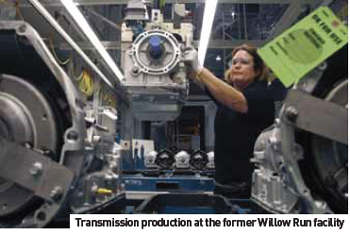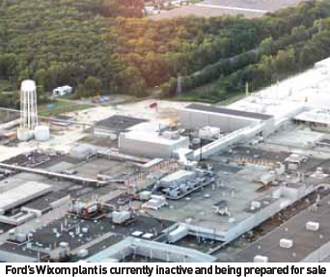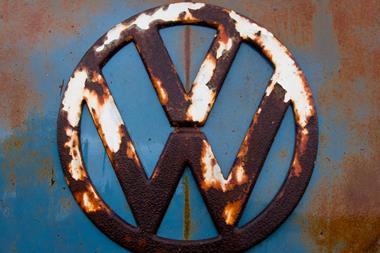
How the remediation of former manufacturing facilities belonging to GM, Ford and Chrysler is – and is not – being carried out, where the money comes from, and who is ultimately responsible for doing the work
The North American town of Kenosha, Wisconsin features a new waterfront development on the Lake Michigan shore. Called Harbor Park, the 69-acre site includes 400 residential condominiums and even two museums. The development can be considered a success on many levels, but a key denominator is the increase in land values since the start of site redevelopment. Over the length of the project, which stretched from 1989 to 2003, the value of the site increased to about $50 million. Yet in 1994, a little over a third of the way through the project, the wasteland that was to become Harbor Park was valued at just $1; the price paid by the city authority for the land.
Before Harbor Park, though, the site had had a very different profile and purpose. In 1960, it became the location for a new assembly plant operated by American Motors Corporation. In 1987, the facility was ultimately purchased by Chrysler, which in 1988 went on to close the operation down with the loss of approximately 5,000 jobs. Now home to the Harbor Park project, it is a prime example of how a former automotive manufacturing site can be adapted for later use. Part of the redevelopment was backed by $18.5 million put forward by the city authority, but sourcing the required cash remains one of the problems stalling other site regeneration projects.
GM and Motors Liquid Corporation
Details of this and similar projects are available in a publication released by the US Environmental Protection Agency (EPA), which examines issues faced by companies and communities when an automotive manufacturing plant is shut down. These are not an occasional occurrence.
Instead, they collectively one of the largest areas of environmental and urban regeneration being dealt with by the business and public sectors in the United States.
 The scale of the problem is illustrated by the number of those displaced following the 2009 bankruptcy of General Motors. Since then, the company’s former manufacturing operations have been reborn under the guise of General Motors Company or ‘New GM’, which holds a large proportion of the original company’s productive assets.
The scale of the problem is illustrated by the number of those displaced following the 2009 bankruptcy of General Motors. Since then, the company’s former manufacturing operations have been reborn under the guise of General Motors Company or ‘New GM’, which holds a large proportion of the original company’s productive assets.
Meanwhile, responsibility for finding a use for what is left over rests with ‘Old GM’ or Motors Liquidation Company (MLC) as it is now formally known.
A spokesman for MLC confirms that what remains under the company’s control is quite substantial. Altogether, MLC is responsible for 89 locations, including 16 manufacturing sites in the UK and one in France, a powertrain plant in Strasbourg. Perhaps not surprisingly, 57 of the sites are located in a single state, Michigan, with the remainder scattered over a further 13 states. Of these, 59 have been classified as being contaminated with hazardous waste. While there is no shortage of sites, what has been in short supply is the money to clean them up - that, though, could be about to end. Should it gain legal approval, a deal is pending that could make about $770 million available for the remediation of these US sites to support their further use. The money will be allocated by an Environmental Response Trust (ERT) charged with ensuring that the clean-up operations are carried out. Of the available funds, some $640 million will come directly from MLC, with the remainder to be delivered by the transfer of the sites to the trust in advance of their individual sale. The money that MLC is putting forward can be traced back to a $1 billion loan forwarded from the US Federal government to ‘Old GM’ in 2009.
Unsurprisingly, given the number of sites involved, a significant chunk of the money - $158 million - will be heading to Michigan. But almost as much, $154 million, will be directed to New York state, where a single site, located in Massena, is expected to gobble up $120 million. Having been used for aluminium diecasting operations for 50 years, the land is heavily contaminated with polychlorinated biphenyls or PCBs. Other states that will receive clean-up cash are: Delaware, Illinois, Indiana, Kansas, Massachusetts, Missouri, New Jersey, Ohio, Pennsylvania, Virginia and Wisconsin. A further site in Louisiana will receive support for ‘repurposing’, although it is not actually deemed to be contaminated. Not all of the money, though, will be used to support direct remediation work. Approximately $260 million will be used for administrative support, marketing and repurposing, while a further $68 million will be held back to deal with contingencies.
The unprecedented deal is described by MLC as representing a ‘real breakthrough’ in the way it handles the complex mix of bankruptcy and remediation requirements.
In fact, it actually makes site remediation and repurposing the primary and ultimately overriding objective of the whole exercise, with the ERT set up as a separate entity. Over time, the MLC spokesman adds, the company itself ‘will cease to exist’. How this will affect repayment of the loan made to GM (and MLC) remains uncertain. In answer to the question, MLC offers only a guarded response: “That is a matter for the Treasury”.
The State of Michigan, which features so highly in the clean-up activities, has taken a proactive and independent approach to the issue. As part of this, it set up Project Phoenix in February 2010 to act as a public sector facilitator for productive re-use of redundant manufacturing sites. While the initiative is not formally confined to the automotive sector, the reality is that former car plants – and particularly former GM facilities – form the bulk of the sites involved.
Penny Launstein, Vice-President of Michigan Retention and Growth, part of the Michigan Economic Development Corporation, says the initiative, which is formally structured as a public-private partnership, can be traced back to Michigan Governor Jennifer Granholm, who set it up as a direct response to the perceived consequences of GM’s bankruptcy. “It was recognised that there would be a lot of spare real estate when GM went into Chapter 11,” Launstein confirms.
 The website for Project Phoenix lists seven ‘Old GM’ manufacturing facilities, plus a further five nonmanufacturing sites. The seven production sites are: Flint North, Livonia, Pontiac Centrepoint Campus – Central, Pontiac Centrepoint Campus – West, Pontiac Assembly, Grand Rapids Stamping and Willow Run, the latter including the company’s Engineering Centre.
The website for Project Phoenix lists seven ‘Old GM’ manufacturing facilities, plus a further five nonmanufacturing sites. The seven production sites are: Flint North, Livonia, Pontiac Centrepoint Campus – Central, Pontiac Centrepoint Campus – West, Pontiac Assembly, Grand Rapids Stamping and Willow Run, the latter including the company’s Engineering Centre.
The sites vary in size, but only Pontiac West comes in at less than one million square feet of floorspace – 600,000ft2, to be precise. The remainder offer incremental size increases, reaching 4.5m square feet at Flint North and a gargantuan 5m square feet at Willow Run, the former home of the Fisher body plant. Launstein describes the sites as ‘industrial dinosaurs’; finding new industrial uses for them has not proven easy. She says that to date, efforts to regenerate the sites have proven fruitless, which could ultimately lead to a drastic revision of the idea that the larger sites might find new industrial uses. “Companies looking for accommodation generally aren’t looking for a million square feet or more,” she states. Launstein has clearly considered alternative solutions: “Maybe the best way forward will be to demolish them and focus on the communities.”
‘Community’ is the key word. From the start, Launstein says the initiative has aimed “to get all the stakeholders in the same room,” – with the local communities placing high on the guest list. She stresses that community involvement can play a genuine role in facilitating effective re-use of a site.
As Launstein explains, local communities were deeply affected by the GM plant closures, but moving on, they have a vested interest in finding new uses for these sites. She describes them as being ‘pro-business’, an essential element for prospective investors investigating renewal strategies. “It is a real incentive for companies that might want to come in.”
Ford outlines site cleanup criteria
While neatly avoiding Chapter 11 proceedings, Ford has also had to implement a programme of site closures. The company has shut down and sold eight production sites in North America over the last six years, with another five already closed or scheduled to close by the end of 2011. Those that were sold included: Ypsilanti and Utica (Michigan); Lorain, Maumee and Batavia (Ohio); Atlanta (Georgia); Edison (New York); and St Louis (Missouri). Wixom, in Michigan and Norfolk, in Virginia, are currently inactive and being prepared for sale, and the clock is ticking for Twin Cities (Minnesota), Indianapolis (Indiana) and St. Thomas (Ontario, Canada).
 The numbers and locations are confirmed by Jay Gardner, Ford’s Director of Global Real Estate, responsible for all “acquisitions, dispositions and transactions” of actual sites, whether for production or other usage. This, on a worldwide basis, with the exception of Europe which, he says, manages its own site issues. Gardner, who is based in Dearborn, Michigan, further states that the numbers for recent and projected site shutdowns, though not huge, represent an overall increase in the trend. He says that the company’s current closure programme is directly related to the downturn in the wider economy. “Until a year ago we were losing market share. We had no choice but to rationalise output accordingly.” The company continues to operate 38 plants – including the three scheduled to close in 2011 – across North America.
The numbers and locations are confirmed by Jay Gardner, Ford’s Director of Global Real Estate, responsible for all “acquisitions, dispositions and transactions” of actual sites, whether for production or other usage. This, on a worldwide basis, with the exception of Europe which, he says, manages its own site issues. Gardner, who is based in Dearborn, Michigan, further states that the numbers for recent and projected site shutdowns, though not huge, represent an overall increase in the trend. He says that the company’s current closure programme is directly related to the downturn in the wider economy. “Until a year ago we were losing market share. We had no choice but to rationalise output accordingly.” The company continues to operate 38 plants – including the three scheduled to close in 2011 – across North America.
Gardner confirms that the majority of the sites involved are related to production, whether for powertrain or assembly. “Most dispositions are industrial,” he says. Irrespective of the site’s former activities, he says that Ford approaches all such ‘dispositions’ using three guiding principles, each of which carry equal importance over a given project.
The first is to ensure the physical clean-up of the site to environmental standards. In the US, though, such standards can vary according to location. As Gardner explains, the responsibility for setting such standards tends to be delegated from the federal EPA to the relevant state authority, which then has considerable leeway in what they can decide to do. But whatever the local variation, he adds that Ford invariably carries out an environmental assessment of the site before embarking on a clean-up programme, carried out in cooperation with the state authority, where soil and groundwater remediation take priority.
The second principle is to establish what the site could be used for after the cleanup by working with the surrounding community. “We work as closely as we can with the community on futuring,” says Gardner. He goes on to say that automotive manufacturing sites tend to be in use for decades, which inevitably leads to close ties between the company, the workforce, and the wider population.
“Typically, we have been in these communities for a long period of time.” It is something the company recognises and acts upon, but he concedes that this must be done in a commercial context: “We have to take account of the state of the market.”
This leads straight into the third principle, which covers recognition of the company as a commercial entity with responsibilities to its shareholders. “We want to profit from an asset,” Gardner confirms. “If we get it off our books then we eliminate the holding costs.”
Taken in isolation, these three principles obviously make for an entirely virtuous wish list. Equally obvious is the reality that in practice, compromises will have to be made to ensure effective resolution of a given situation. “These things can clash and we are always trying to resolve them,” says Gardner. “It is a bit like trying to solve a quadratic equation.”
One factor that holds true across all sites is that the ‘polluter pays’. In most instances, Ford will carry out whatever remediation work is necessary, though this will sometimes only start after a site is sold. What may influence this process is the intended later use of the site, since preparation for residential construction will necessarily be more intensive than repurposing for industrial usage. That said, remediation work could still be passed from Ford to the site purchaser as part of the deal, with the purchase price adjusted accordingly. This was the case with the sale of the company’s site in Lorain, Ohio.
This, though, could mean trouble. Should the purchaser subsequently default on their obligations, it would affect both the local community and, by association, Ford’s own reputation. This is not a theoretical circumstance, but one that actually happened. What was the conclusion to that episode? “We bought the site back,” says Gardner.
With regards to the actual cleanup process, Gardner says that there are two categories of problem that old automotive plants tend to leave behind. The first is hydrocarbon contamination, usually from underground tanks that were, until relatively recently, a common feature of large automotive plants. The other is paint sludges. Both, says Gardner, are the products of manufacturing processes that are no longer used, but are common at sites that have been in operation for 80 years or more.
Aside from contaminants, the most problematic area of site clean up remains funding for the clean-up operations and maintaining channels of communication between former site operators, potential purchasers and the local community. Kenosha’s Harbor Park is an example of what can be achieved if this is managed correctly.
Yet the town has suffered a second blow, following the October 2010 closure of Chrysler’s Kenosha Engine Plant, which had survived the previous round of plant closures.
Even with the gradual winding down of the facility, the closure meant the loss of almost 600 jobs. Unfortunately, as Keith G. Bosman, Mayor of Kenosha, relates, the former engine plant is neither as picturesque or attractive in terms of size as Harbor Park. Instead, the site sprawls across 109 acres of inner-city land, an area nearly double that of the 60-acre the residential development. Located in close proximity to some of the city’s other major residential areas, there is great concern about what might happen in the future.
The site could continue to be zoned for industrial use, but while some of the buildings are nearly 100 years old, Bosman says that some others on the site were built less than 10 years ago at a cost of about $500 million, part of the investment to support production of Chrysler’s ‘Phoenix’ engine. The mayor says that he is concerned that such ready-made infrastructure could attract companies simply looking to strip the buildings for salvage, rather than find a productive use for the site. “We don’t want someone to just come in and take the copper and steel,” he observes.
While the mayor is keen to emphasize that this is an eventuality that will not be allowed to happen, the city authority has not as yet involved itself with the site’s sale.
He goes on to say that a commercial real estate dealer has possible purchasers currently considering potential uses for the land. “We are letting this play out,” he confirms. But Bosman adds that that the city’s patience is not limitless. If there is no resolution to the matter over the next six months, the city could exercise its power to take possession of the site and oversee its remediation. He adds that this cleanup could cost between $30 and $40 million, but he is not put off. “We have already got a promise of $10 million,” he says.
None of the money will come from Chrysler, as the mayor candidly observes: “Old Chrysler hasn’t got any assets.” As such, cities like Kenosha feel that the money poured into GM by the Federal government should be matched by an equal amount of funding to help clean disused sites. Lobbying for this has already started, through the setting up of a Mayors and Municipalities Automotive Coalition (MAC), which Bosman says involves at least three dozen city authorities throughout the US.
The organisation’s fundamental objective is to set up a Federal Automotive Stabilzation Trust with sufficient funding to tackle problems left in the wake of recent and projected automotive plant closures. Problems caused by Chrysler’s bankruptcy and creation of the Old Car Company (the name given to Old Chrysler) loom large in for the trust - Bosman estimates the required sum will be in the region of $375 million.
Until the funding can be found to prepare all derelict automotive sites for resue in order to give them new leases of life, they are shaping up to be sources of real political and social concern.


































